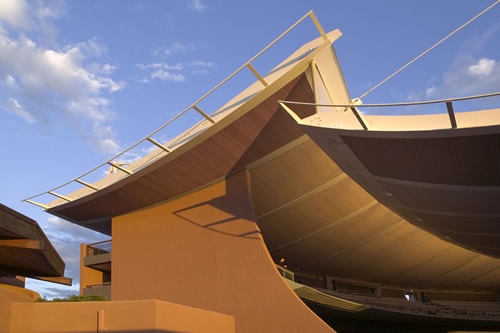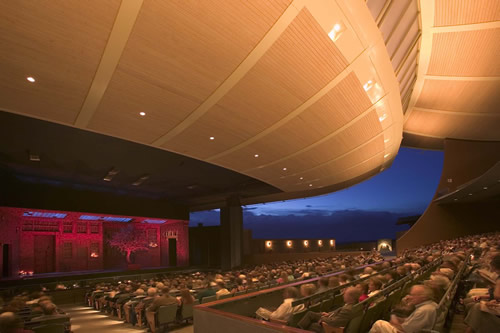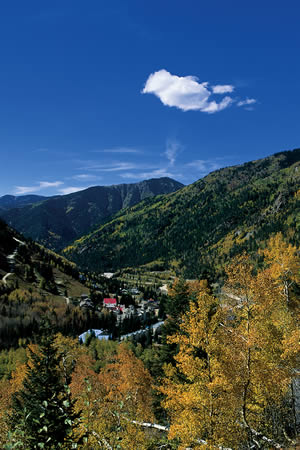Salzburg in New Mexico’s Santa Fe - 2006
by Peter Pabisch
Since 1957, when the Santa Fe Opera House was founded, Opera lovers have been drawn to New Mexico to enjoy the Summer Opera Festival. As Peter Pabisch illustrates in the following article, the summer festivals in America’s mecca of opera in Santa Fe have become a tradition much like that in Salzburg. Works by great Austrian composers like the Salzburg festival’s founders, Richard Strauss and Hugo von Hofmannsthal, are performed regularly in Santa Fe. Yet, for the opera world, there are many other remarkable parallels between the two cities.
In 1957, “Time [magazine] wondered if Santa Fe would become ‘the Salzburg of the Southwest,’ raising for the first time a comparison with the venerable Austrian festival that would prove apt in a surprisingly short time.” This statement by Phillip Huscher highlights his new book, “The Santa Fe Opera: An American Pioneer,” published in 2006 on the occasion of the opera house’s 50th Anniversary. It shows the auspicious beginning of the Santa Fe Opera House and the long and successful path it has taken over half a century.

Santa Fe Opera House
Today no one doubts the worldwide reputation of this opera house and its comparison with the renowned Austrian city. Operas by two of the Salzburg festival’s founders, Richard Strauss and Hugo von Hofmannsthal, are performed regularly in Santa Fe. Richard Strauss’ operas have found a haven here, and one of them is performed each summer season, as Salome was in 2006. From its founding, and for several seasons thereafter, Igor Stravinsky personally conducted his works and gave his advice freely to the new company. This allowed the Santa Fe Opera House to evolve as one of the decisive interpreters of his operas - Mavra, Oedipus Rex, Persephone, Renard, The Rake’s Progress - which played for eight summers, and Le Rossignol which has been performed for the last five seasons.
Since its opening fifty years ago, 137 operas have been produced, including ten world premieres and forty-two American premieres. Among the composers from Austria, Wolfgang Amadeus Mozart has been represented almost every year, especially his popular works, The Marriage of Figaro, Cosi fan tutte, Don Giovanni and, of course, The Magic Flute. Additionally, Franz Lehár, Johann Strauss, Jr. (Die Fledermaus), Arnold Schoenberg and Alban Berg (with the American premieres of Woyzzeck and Lulu, respectively) have been included in the program. Other composers prominent in Vienna, such as Emmerich Kálmán (Countess Maritza), Krzysztof Penderecki, Erich W. Korngold or Alexander von Zemlinski are all among the some seventy chosen opera and operetta composers who have been featured since the Santa Fe opera’s inception.

Santa fe Opera House
The significant rise of the Santa Fe Opera can be attributed to the contributions of culturally enthusiastic people. Several of them were former Jewish Austrians who fled their occupied country and started their life anew in the States. Many of them are now deceased but while here they sustained the music scene in and around the city. One example was Kurt Frederick, who founded the nationally and even internationally successful ‘Albuquerque Youth Symphony Orchestra’ and the regionally well-known ‘Opera Southwest,’ now the ‘Albuquerque Civic Light Opera Association’ (ACLOA). Immediately after World War II, as a conductor of the University of New Mexico Orchestra, Frederick offered the American premieres of several works by Ernst Krenek and Arnold Schoenberg. His colleague, pianist George Robert, a former member of the ‘Seraphim Trio’ and interpreter of much of the world’s piano literature, left his mark most noticeably. George Robert, formerly Georg Katz, played in Vienna’s Konzerthaus as a ‘Wunderkind’ in 1935 and was heard as recently as a year ago when he accompanied an American singer in Franz Schubert’s/Wilhelm Müller’s Winterreise. Earlier this year, shortly before his 87th birthday, he left us with an impressively large circle of family, friends, and colleagues as well as a large general audience who honored him with two farewell concerts. His last Winterreise performance is available on CD.

Scenic View of the village of Taos Ski Valley
- Born in Vienna, Peter Pabisch has lived in New Mexico since 1972. He is Professor Emeritus of German and European Studies at the University of New Mexico in Albuquerque as well as co-founder (1975-76) and co-director of the German Summer School of New Mexico located in the village of Taos Ski Valley. Writer of lyric and poetry, he has also published numerous academic titles on German authors. Among other awards, he is recipient of the Grand Decoration of Honor by the Republic of Austria and is also member of the Austrian P.E.N.
SANTA FE OPERA
2007 SEASON OVERVIEW
La Bohème
Music by Giacomo Puccini
Text by Giuseppe Giacosa and Luigi Illica
Così fan tutte
Music by Wolfgang Amadeus Mozart
Text by Lorenzo da Ponte
Performance Dates: June 30; July 6, 11, 31; August 6, 13, 20, 24
Daphne
Music by Richard Strauss
Text by Josef Gregor
Performance Dates: July 14, 18, 27; August 2, 8, 17
Tea: A Mirror of Soul
American Premiere
Music by Tan Dun
Text by Tan Dun and Xu Ying
Performance Dates: July 21, 25; August 3, 9, 15, 23
Platée
Music by Jean-Philippe Rameau
Text by Adrien Le Valois d’Orville
Performance Dates: July 28; August 1, 10, 16, 22
